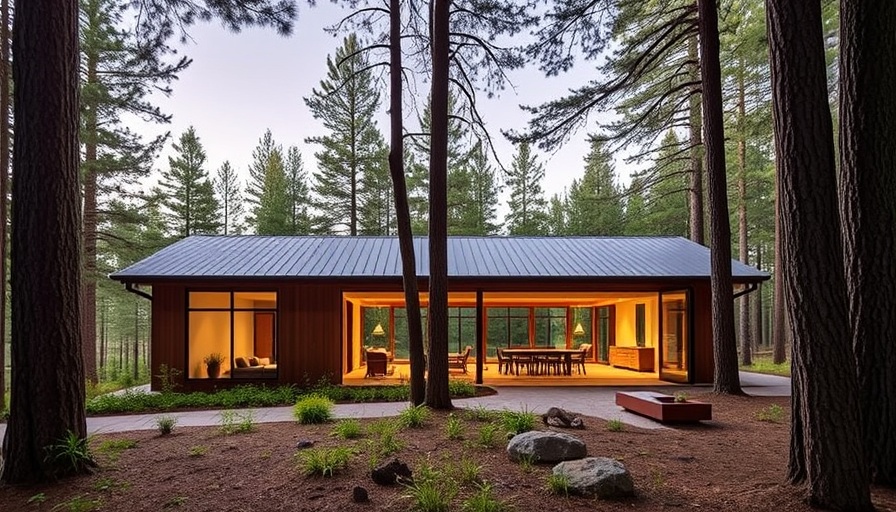
Creating an Ideal Workspace: The Moss Rock Home Office
In the heart of California’s wine country, a stunning new home office, designed by Swatt + Partners, offers an inspiring model for digital nomads seeking efficient and aesthetic remote workspaces. Known as Moss Rock, this architectural marvel demonstrates how thoughtful design can create a productive environment immersed in nature.
Designing for Comfort: Lessons from Moss Rock
The Moss Rock home office is nestled on a nine-acre property in Healdsburg, surrounded by lush forests and rolling hills. The structure is composed of two vertical concrete slabs supporting a wood-framed glass box, which not only floats above the landscape but also ushers in ample natural light and picturesque views. This design highlights the importance of integrating environmental elements to foster a comfortable workspace, making it easier to stay focused and inspired while working remotely.
Using natural materials like Western red cedar for cladding creates a calming aesthetic, contributing to an atmosphere conducive to productivity. Digital nomads often find that incorporating elements from nature - such as wood textures and greenery - into their workspace leads to greater satisfaction and reduced stress levels. Balancing aesthetics with functionality, the Moss Rock office provides an intriguing model for remote workers.
Maximizing Efficiency: Ergonomic Design Principles
As an ergonomics specialist, I recognize the role of workspace design in maintaining health and productivity. In the case of the Moss Rock home office, the layout focuses on accessibility and flow, with an open interior space that allows for natural movement. An ergonomic setup can significantly improve comfort during long work hours. Consider the following principles inspired by Moss Rock:
- Adjustable Furniture: Incorporate desks and chairs that can be adjusted for height to promote good posture.
- Natural Light: Position your workspace near windows to benefit from sunlight, which can improve mood and productivity.
- Minimal Distractions: Create a clear space that minimizes clutter, allowing for enhanced focus on tasks.
Creating an Aesthetic Environment: The Impact of Beauty on Productivity
The Moss Rock office demonstrates that beauty in design has tangible benefits for productivity. With its elegant lines and glass walls, the space is not only functional but also uplifting. Research has shown that visually appealing environments can enhance motivation and creativity.
For remote workers, creating a workspace that not only meets practical needs but also pleases the eye can transform daily tasks. Simple elements like artwork, plants, or even light decor can establish a more inviting atmosphere. This experiential aspect encourages longer, more productive work sessions, particularly in a home office setup.
A Broader Perspective: Remote Work Trends
The design of spaces like Moss Rock speaks to the growing trend of remote work across various industries. As digital nomads continue to seek out environments that support their lifestyle, the demand for uniquely designed home offices is increasing. Architects and designers are now more focused on creating spaces that embody both function and beauty, enhancing the user experience while accommodating the needs of remote workers.
This trend is not limited to independent workers; companies are also beginning to embrace flexible work arrangements, recognizing the importance of having well-designed spaces that can foster creativity and collaboration. With a focus on health and well-being, companies are realizing the potential benefits of investing in ergonomic, aesthetically pleasing workspaces.
The Future of Workspace Design
As we look ahead, the concepts embodied by the Moss Rock home office will likely shape the future of workspace architecture. Emphasizing harmony with nature, ergonomic principles, and efficient design, these elements will be crucial for future projects aiming to serve the evolving needs of remote workers. From infinity pools to expansive glass views, the harmonious blend of workspace and environment can redefine productivity.
For digital nomads and remote workers, creating a workspace that nurtures creativity and supports comfort is essential. As demonstrated by the thoughtful design of Moss Rock, aligning your workspace with your lifestyle can lead not only to increased productivity but also to personal fulfillment. Each effort to enhance your remote workspace can yield significant benefits in your professional and personal life.
Call to Action: Choose to prioritize your workspace design. Take a cue from Moss Rock and transform your remote working environment into an inspiring and productive haven.
 Add Row
Add Row  Add
Add 




Write A Comment